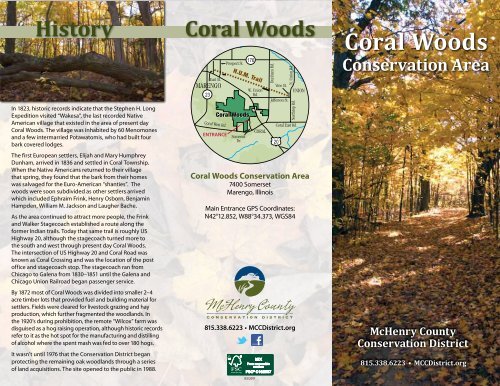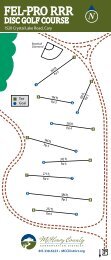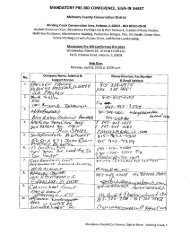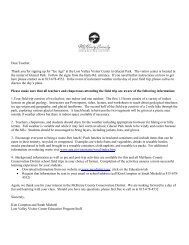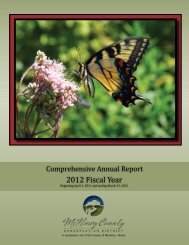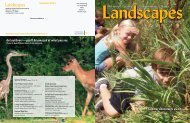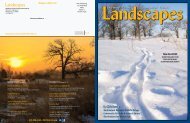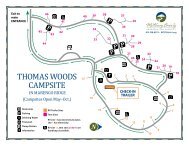Coral Woods - McHenry County Conservation District
Coral Woods - McHenry County Conservation District
Coral Woods - McHenry County Conservation District
You also want an ePaper? Increase the reach of your titles
YUMPU automatically turns print PDFs into web optimized ePapers that Google loves.
PreservationDominated by a core of century old red and white oaks,the environmental significance of <strong>Coral</strong> <strong>Woods</strong> is theprotection of these diminishing oak woodlands. <strong>Coral</strong><strong>Woods</strong> represents one of only eight oak groves whichremain in <strong>McHenry</strong> <strong>County</strong> that contains 100 acresor more of continuous oak woodland. This 775-acreconservation area also boasts the county’s largest sugarmaple grove where trees have stood for 80-100 years.Mike SchultzRed trilliumIn autumn the brilliant colors ofred, orange, and yellow leavesfrom oaks, hickories, and sugarmaples make this a favoritefall hiking spot. In the spring,these woodlands are also notedfor their spectacular show ofspring wildflowers. Sharp-lobedhepatica, Jack-in-the-pulpit,wood anemone, spring beauty,toothwort, and bloodrootgive way to wild geranium,blue phlox, and red trillium.Throughout the year, the trees at <strong>Coral</strong> <strong>Woods</strong> arean attractive respite for numerous songbirds, owlsand woodpeckers. Scarlet tanagers, indigo buntings,numerous warblers, flickers, bluebirds, meadowlarks,great horned owls and screech owls, as well as downyand hairy woodpeckers claim these woods as theirhome. Nesting boxes are also strategically placedalong the edge where prairie and woodland meetto encourage the re-population of bluebirds.Chorus frogs, tiger salamanders, leopard frogs, andpainted turtles can often be seen enjoying thespringtime vernal pondsalong the trail.RecreationHiking<strong>Coral</strong> <strong>Woods</strong> offers threetrail systems. The SugarMaple Loop trail is a short.4 mile walk off the parkinglot. During the fall this traildisplays an array of vibrantred, yellow, and orangecolored leaves.For a longer trek, the1.2 mile Nature Loop trailis known for its woodlandwildflowers during thespring months. The 1.2 milehiking/ski trail is another favorite. Visitors can hikethrough maples, oaks, and a grassy sloping field.Wildlife is active in the these woods and visitors aresure to catch a glimpse of deer, numerous birds, andan occasional turtle enjoying the seclusion of anephemeral pond.Cross Country SkiingIn the winter months when 4 inches of snow is present,1.5 miles of trails are open for cross country skiing. Trailsare not groomed but they are on relatively flat terrain,ideal for beginning skiers.Picnic Facilities Picnic tables are located near the trailhead for those who wish to enjoy a quiet picnic lunchsurrounded by nature’s beauty. A picnic shelter withfireplace is located just off the Sugar Maple Loop trail andcan accommodate up to 40 people. Reservations for theshelter can be made by calling the <strong>District</strong>’s main office.Bird watching Bird watching is popular at <strong>Coral</strong><strong>Woods</strong> during migrations, as well as during the summerwhen many birds nest in the branches of the maturewhite oaks. Watch for the white-breasted nuthatch,northern flicker, red-eyed vireo, scarlet tanager, Americangoldfinch, indigo bunting, blue jay, robin, downywoodpecker, great-crested flycatcher and cedar waxwing.SpecialProgramsPlanting for TomorrowDedicated to preserving,restoring and managingthis unique natural area, the<strong>Conservation</strong> <strong>District</strong> began apublic outreach program to assist in the reforestationefforts of <strong>Coral</strong> <strong>Woods</strong>. Five acres were planted withover 750 oak and hickory trees through donations fromthe public. A second 10-acre parcel was identified andphase two of the reforestation efforts began in 2011.Each spring and fall, staff and donors work togetherto plant the donated 3’–5’ oak and hickory trees.<strong>Coral</strong> <strong>Woods</strong> was once a 3,000 acre woodland.As the area was settled the woods were fragmentedand cleared. The Planting for Tomorrow Program willhelp ensure that the acres that remain will exist forgenerations to come.Festival of theSugar MaplesThe Native Americanscalled it “Sisibaskwat” ortime of the melting snow.It is a time in March whenthe weather see-sawsSap collection bucketsfrom cold winter nightsto warm spring days. Thewarmer weather causes a tree’s sap to flow up the trunkto feed new leaf buds. This is also the time for the annualFestival of the Sugar Maples.The Festival of the Sugar Maples is held overtwo weekends in late February and earlyMarch. The festival celebrates the culturalhistory of maple sugaring, teaches aboutthe process of how sap is turned into maplesyrup and demonstrates the improvementsthat have been made in maple sugar production. Over40 trees are tapped for the event and free tours aregiven to local school groups and weekend visitors.Chorus Frogs
<strong>Coral</strong> <strong>Woods</strong> <strong>Conservation</strong> AreaTEXTURES KEYForests/<strong>Woods</strong>Grasses and ForbsSedge MeadowWaterU.S. Hwy 20W. Union Rd.Hiking/ Ski Trail 1.2 MilesNature Loop 1.2 MilesDunham Rd.SYMBOLS KEYMaintenence RoadCross Country SkiingSugar Maple Loop 0.4 MilesDrinking WaterHikingNature TrailInformationMaple St.ParkingPaved TrailPlanting for Tomorrow AreaPicnic AreaRestroomsShelterSomerset Dr.U.S. Hwy 20E. <strong>Coral</strong> Rd.W. <strong>Coral</strong> Rd.ENTRANCES. <strong>Coral</strong> Rd.Natural CommunitiesGlacial MoraineWhen the glaciers retreated, they leftbehind piles of debris made up ofcrushed rock and sand, ranging in sizefrom silt to large boulders, that createdcharacteristic landforms.Maple Woodland The heavy canopy of mapletrees within a woodland community provide littlelight to the understory. The result is a lack of shrubs.However numerous wildflowers and herbs provideground cover that brightens the woodland floor in early spring before the leafed canopyreturns. Groves of maples are typically found on flat or rolling terrain where there is avariety of moist soils that contain high levels of organic matter.Traditionally, maple trees are valued for use as timber for fuel, furniture, flooring andcabinetmaking. However, maple trees are also known for their source of maple sugar.This important sweetener was first prepared by Native Americans and then become astaple used by colonists. It remained important until 1875 when maple forest stands weredepleted and cane sugar gained precedence due to its lower manufacturing cost andhigher saccharine content.Oak WoodlandBur, white, black, red and scarlet oak species areall found in oak woodlands. Characteristically,oak woodlands are more shaded than savannasand trees grow straighter as they competefor light. Trees on the steeper, more ruggedtopography may appear to be higher in densityper acre because they were harder for settlers toget to and thus, survived logging and clearing.SavannaSavannas are open wooded areaswhere trees are widely scattered.Savannas are transitional communitiesbetween woodlands and grasslandsand provide an array of food andshelter for numerous species of wildlife.


